When it comes to choosing trees for your landscape, native Florida species are a great option. They look beautiful and are well-adapted to the climate and soil of the state. Smaller trees like redbuds or red maples will make any yard pop in the spring with their bright pink or red flowers, while larger options like bald cypresses or live oaks will provide shade and help create a statement piece in your landscape. It’s important to research each tree you’re considering so you know its exact needs when it comes to light, water, and soil requirements; this is true even if you choose a native species. Some of our favorite native Florida trees include cypress, elm, and pines – all of which feature unique foliage that can add texture and interest to any garden!
Native Cypress Trees
Two types of cypress trees are native to Florida. These trees are important for the state’s economy and ecology. Cypress trees often grow in large, circular patches called cypress domes. In the middle of these cypress patches is usually a pond. There are also areas of marshland known as cypress savannas, which are mostly made up of pond cypress trees that grow in poor soil.
- Bald cypress trees are some of the oldest living trees in North America, with some individual specimens having lived for over 1,000 years. They can grow up to 150 feet tall and have a distinctive red-brown bark that provides excellent insulation from cold temperatures. Their roots also form outgrowths called “knees,” which help them survive in wet environments like swamps or areas prone to flooding.
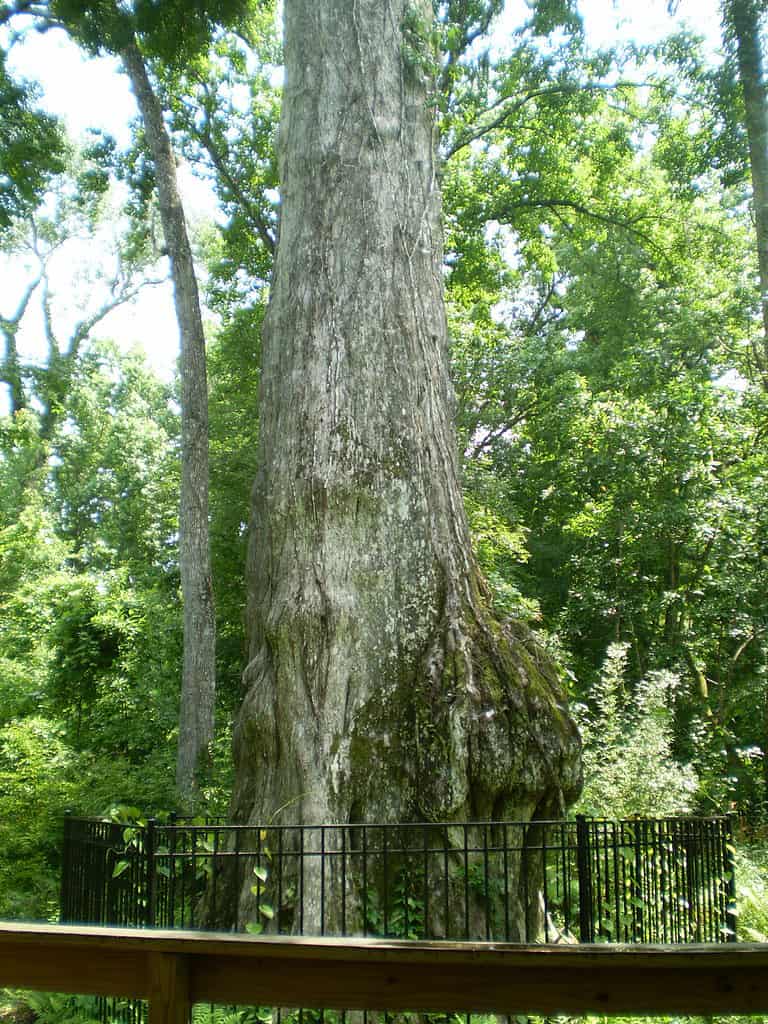
The oldest tree in Florida is a 2,000-year-old bald cypress tree called Lady Liberty.
©EvelynGiggles / Flickr – License
- Pond cypress is another type of cypress tree native to Florida, but it is generally shorter and has thicker, shaggier bark than its bald counterpart. These trees can tolerate water up to several feet deep and are ideal for landscapes that experience frequent flooding. However, pond cypress trees grown in drier areas may not produce the characteristic “knees” associated with this species. Both types of cypress make good landscaping choices as they provide shade and attractive foliage during warm seasons while losing their leaves and cones during cooler months.
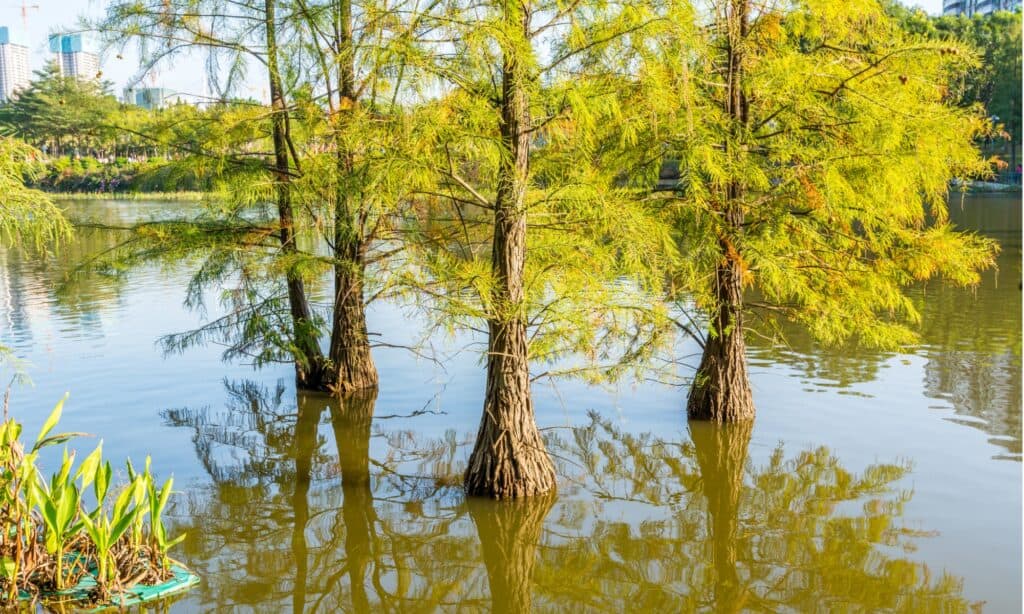
is another type of cypress tree native to Florida, but it is generally shorter and has thicker, shaggier bark than its bald counterpart.
©iStock.com/ZZ3701
Native Oak Trees
There are many species of oak trees native to Florida, many of which are common and attractive. These trees provide valuable habitat and food for wildlife, and some offer showy autumn foliage. Oaks are typically strong and durable, and when pruned properly, many of them are fairly hurricane-resistant. Here are 11 of our favorite Florida oak trees.
- Laurel Oak – A dense and fast-growing oak with a beautiful oval canopy
- Shumard Oak – Stately oak with a round canopy and leaves up to 8 inches long.
- Southern Red Oak – Durable oak with shiny leaves and abundant acorns.
- Water Oak – Abundant acorns, yellow fall color, great for naturalizing.
- Willow Oak – Popular shade tree in parks, grows 70 feet tall, with willow-like leaves.
- Bluff Oak – Scaly gray-brown bark, no fall color, green flowers in spring.
- Chinkapin Oak – 90 feet tall, with strong branches, red and orange in fall.
- Southern Live Oak – 80 feet tall, curved trunk, impressive, wide canopy.
- Overcup Oak – Slow growth, 100 feet tall, twisted trunk, leathery leaves.
- Post Oak – Twisted branches, dense round canopy, 50 feet tall, many acorns.
- White Oak – Long lifespan, 100 feet tall, red fall color, large diameter trunk.
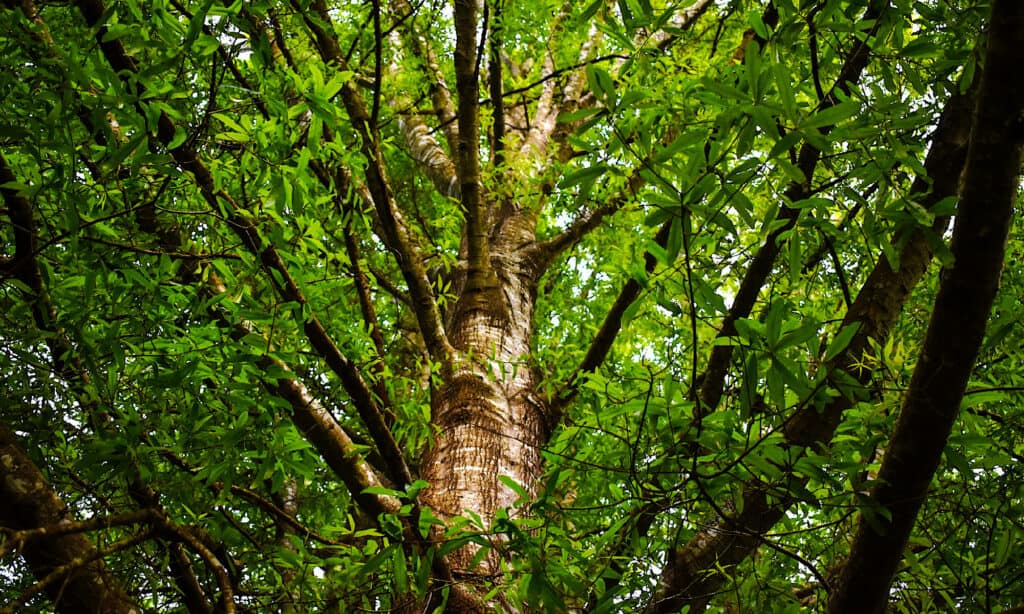
The Willow oak is a popular shade tree in parks, grows 70 feet tall, with willow-like leaves.
©iStock.com/Caytlin Endicott
Native Fruit Trees
There are many types of fruit trees native to Florida. There are also berries, vines, palms, and nuts that are edible and grow throughout the state. Many native plant species in Florida could potentially be domesticated and cultivated as new types of fruits and vegetables. These plants are resilient against pests and pathogens and can withstand extreme weather conditions, making these fruit trees ideal for Florida gardeners. Here are a few of our favorite fruit trees in Florida.
- Chickasaw Plum – Grows throughout Florida. Produces sweet fruit. zones 5-9
- Flatwoods Plum – Tart fruit. Often made into jelly. Zones 8A through 9B
- Cabbage Palm – Florida state tree. Bud is edible and tastes like cabbage.
- Pecan – Pecan trees can be found in all regions between Pensacola and Miami.
- Persimmon – Zones 4B through 9B. Jelly-like flesh is eaten with a spoon.
- Red Mulberry – Grows naturally all over Florida. Needs very little maintenance.
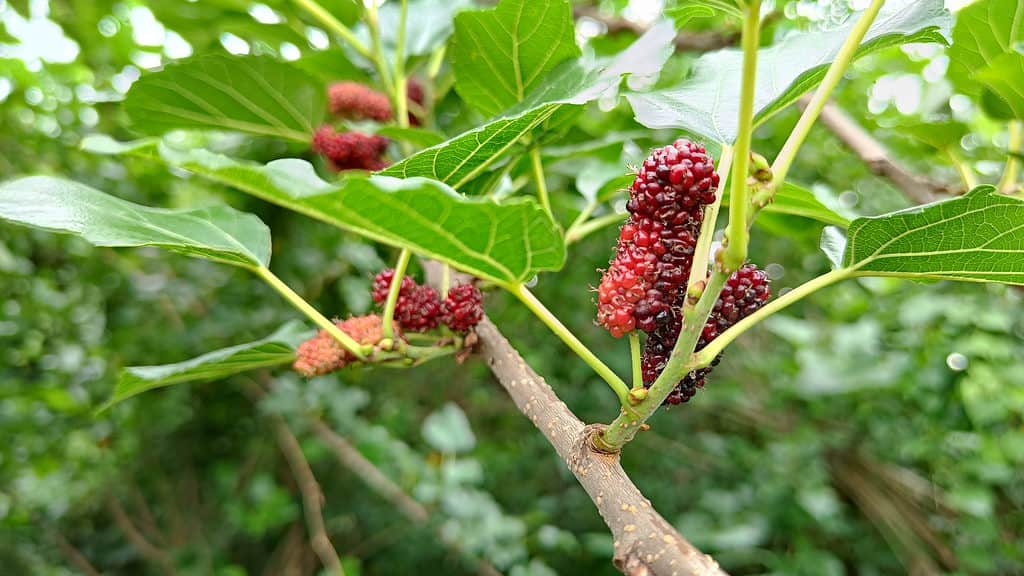
Morus rubra, commonly known as the red mulberry, is native to Florida.
©iStock.com/Witsanu Patipatamak
Native Pine Trees
Florida is home to seven species of native pines, which are part of the larger pine family of cone-bearing plants (conifers). These trees and shrubs are known for their diversity and hardiness, and they are evergreen, meaning they keep their leaves all year round. Although most pines are better adapted to cooler climates, the species that grow in Florida are able to thrive in warm weather.
Slash Pine
The slash pine is one of the most iconic trees in Florida, growing in every climate zone from 7A to 11. This tree grows in the cooler half of Florida and up into the Smokey Mountains. Slash pines are extremely fast-growing and self-pruning, with a mature height that ranges between 75 – 100 feet tall.
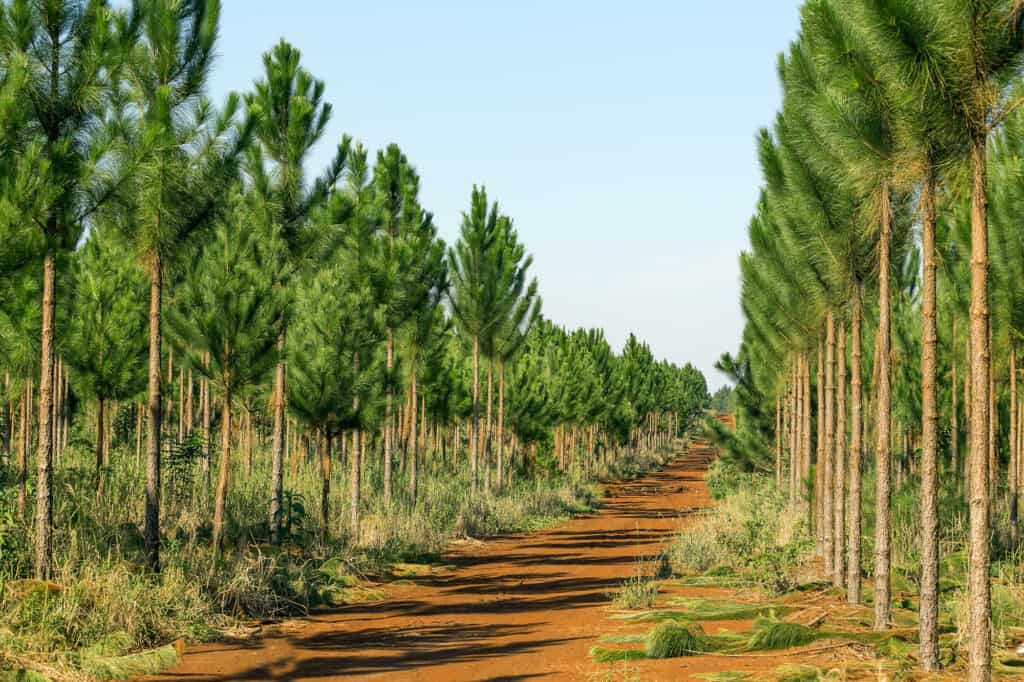
Slash pines can grow in swampy conditions.
©Pablo Rodriguez Merkel/Shutterstock.com
Sand Pine
The sand pine is a species of tree found in sandy areas throughout Florida. It can be identified by its zone range (7A through 10B) and size (15-40 feet tall). Sand pines have short needles 2-3 inches long and often have twisted trunks and branches.
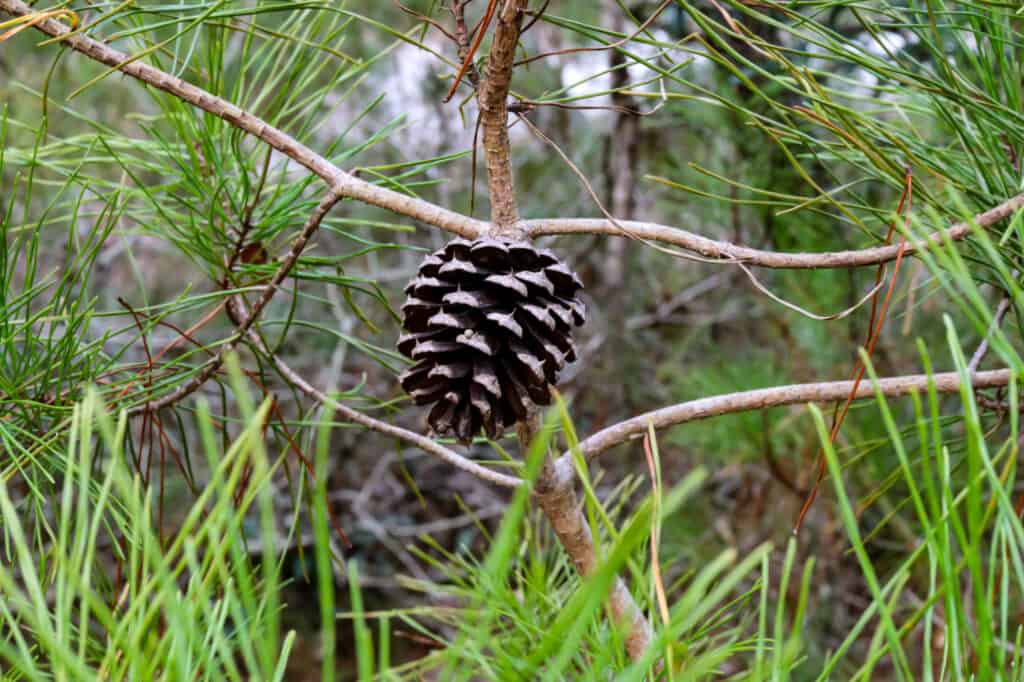
Native to Florida, sand pines thrive where other pines do not.
©John_P_Anderson/Shutterstock.com
Longleaf Pine
Longleaf pines are native to Florida, and they prefer warm climates. They grow in USDA Hardiness Zones 7A through 10A, which encompass most of Florida. Longleaf pines are well-named. they have the longest needles of all pine species found in Florida. Some can reach a whopping 14 inches long.
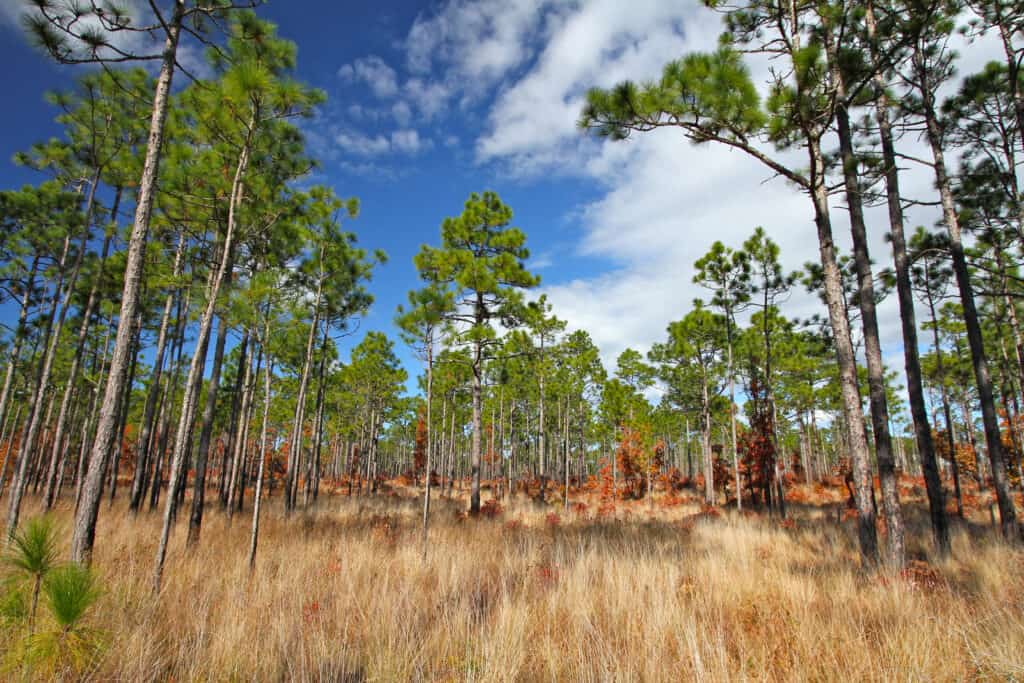
Longleaf pine trees have needles that can grow 14 inches long.
©Ryan McGurl/Shutterstock.com
Loblolly Pine
Loblolly pine is a common choice for pine plantations in Florida. This tree often reaches between 50 and 80 feet tall but can grow up to 100 feet with a spreading crown. This pine does best in loamy soil and is almost never found in wet ground or sandy areas. Because loblolly quickly takes over unused fields, it is also called “old field pine.”
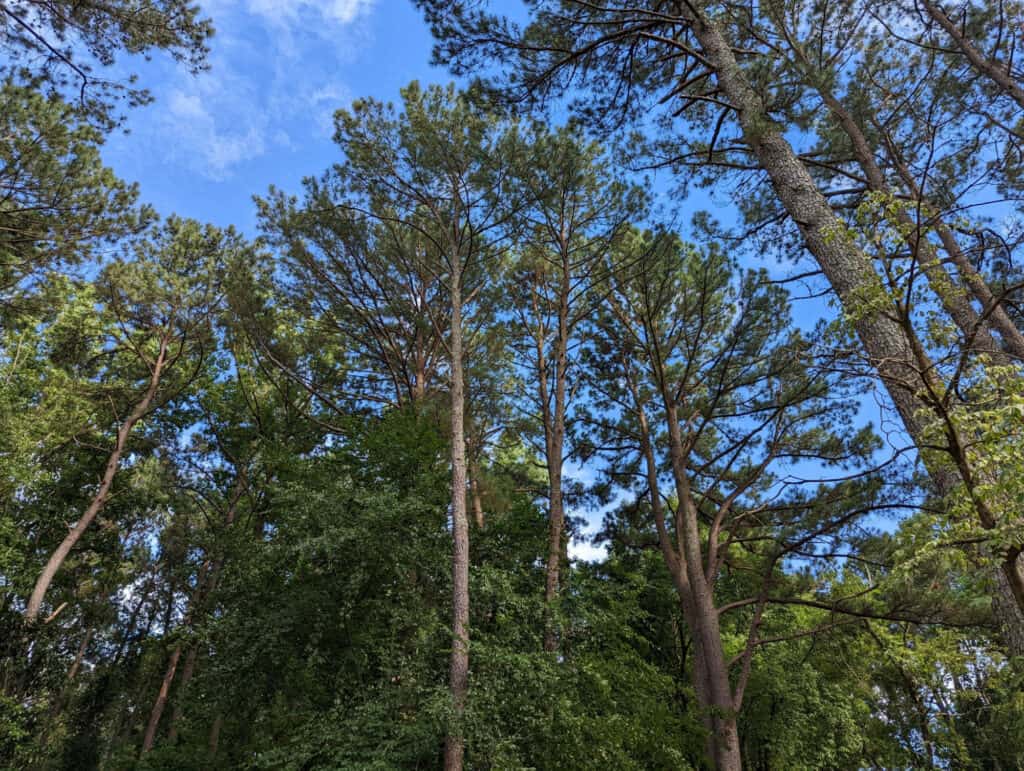
Loblolly pines are native to Florida and the second most common tree in the US.
©Sierra Tango/Shutterstock.com
Pond Pine
The pond pine is a type of tree found in North and Central Florida. These trees tend to grow in poorly drained areas, such as flatwoods or near ponds. Pond pines are often confused with loblolly pines because they have similar-looking needles. Both types of trees have needles that are 5-6 inches long and come in bundles of three (or sometimes two or four). However, pond pine cones are smaller, only 2-3 inches, and more egg-shaped.
Spruce Pine
Spruce pines are a species of evergreen trees native to the southeastern United States. Named for their silver-gray bark, reminding naturalists of spruce trees, they are one of Florida’s least common pines. Their location is in zones 8A through 9B. They can be found growing among loblollies and hardwood trees because they are the most shade-tolerant out of all the other types of pines in Florida.
Shortleaf Pine
Shortleaf pines are a species of coniferous tree native to only North Florida, west of the Suwannee River. While they occupy the same range and habitat as spruce pine, looking at the bark of mature trees is the best to tell them apart. Shortleaf pines have reddish-brown bark, while spruce pine has silvery gray bark. Additionally, shortleaf pines are identifiable by their cones. The cones are considerably smaller than those of other Florida pine species; with an average length ranging from 1.5 to 2.5 inches in length. They make for some of the smallest found in all varieties of Florida’s native pines.

Valued for timber, shortleaf pines are named after the Latin word for hedgehogs.
©Formatoriginal/Shutterstock.com
Native Palm Trees
Are palm trees native to Florida? Although there are 12 palm trees native to Florida, only two of them are endemic. Florida is the only place you will find them. You can find the other ten palm trees native to Florida in other locations outside of Florida. Here are the 12 palm trees native to Florida:
- Everglades Palm – Swamps, marshes, and everglades.
- Florida Silver Palm – Found in rockland areas, usually mixed with pine.
- Key Thatch Palm – small palm found at the edges of hardwood hammocks.
- Florida Cherry Palm – medium-sized palm found in limestone soil near coastlines.
- Needle Palm – Shrubby palm found in wet hammocks.
- Cuban Royal Palm – Found on hillsides, valleys, swamps, and hardwood hammocks.
- Scrub Palmetto – 6-foot tall, fan palm. Grows in the scrub.
- Miami Palmetto – Creamy white flowers and black fruits. It may be extinct.
- Dwarf Palmetto – small palm, frost tolerant. Moist areas.
- Cabbage Palm – Grows 65 feet tall. Edible buds.
- Saw Palmetto – Grows 10 feet tall. Hardy and slow-growing.
- Florida Thatch Palm – Thick and low growing. Common landscaping tree in zones 10b to 11a.

The cabbage palmetto has a thick, fibrous trunk that supports its large fronds.
©iStock.com/JillianCain
Florida Elm
The Florida elm is a great choice for a long-living shade tree. It is fast-growing and can reach up to 80 feet tall. The leaves are dark green and fade to yellow in the fall. It also produces small green flowers in the spring. The Florida elm is moderately tolerant of drought and salt spray and is also used for making furniture and canoes.
Florida elm is an important part of the ecology in Florida. It provides food and shelter for wildlife, as well as shade from the hot summer sun. The seeds provide a valuable source of nutrition to many species of birds, including cardinals and mockingbirds. Rabbits, deer, and other small mammals eat its bark. In addition to providing food, the tree’s dense canopy creates a safe haven for animals such as squirrels or opossums seeking refuge from predators or inclement weather.
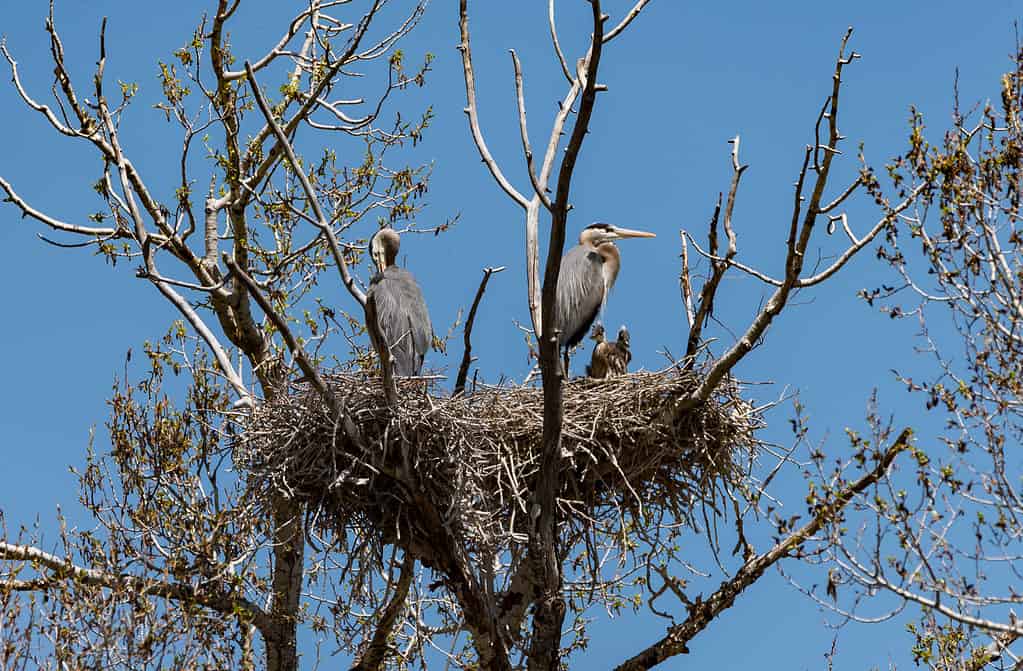
Florida elm is an important part of the ecology in Florida. It provides food and shelter for wildlife, as well as shade from the hot summer sun.
©mark smith nsb/Shutterstock.com
Florida Maple
The Florida maple is a beautiful tree that can reach up to 60 feet in height. It is known for its stunning fall colors, which can range from muted yellows to oranges. Older trees also have very attractive gray bark. This maple tree is ideal for use as an ornamental or shade tree in Florida due to its higher heat tolerance.
The Florida maple is an important tree for wildlife, providing an early spring source of nectar for bees and a home for birds and squirrels. Pollinators visit its flowers, and songbirds, bluejays, and mockingbirds eat its seeds.
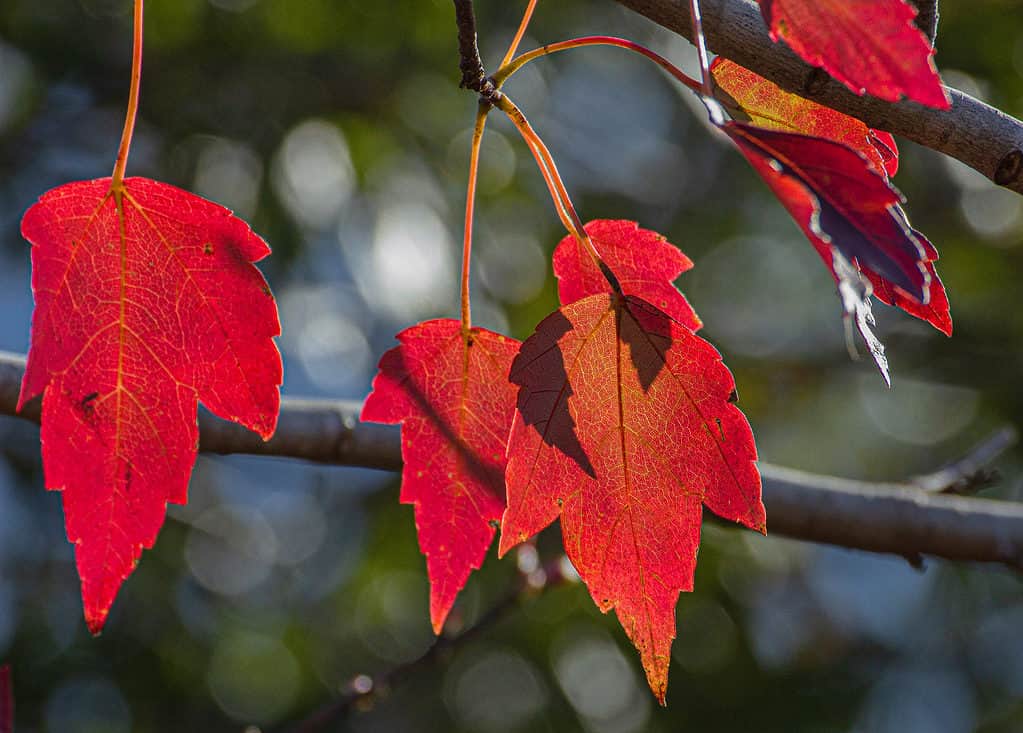
The Florida Maple Tree is known for its stunning fall colors, which can range from muted yellows to oranges.
©Ken Donaldson/Shutterstock.com
Summary of 39 Trees Native to Florida
- Bald Cypress
- Pond Cypress
- Laurel Oak
- Shumard Oak
- Southern Red Oak
- Water Oak
- Willow Oak
- Bluff Oak
- Chinkapin Oak
- Southern Live Oak
- Overcup Oak
- Post Oak
- White Oak
- Chickasaw Plum
- Flatwoods Plum
- Cabbage Palm
- Pecan
- Persimmon
- Red Mulberry
- Slash Pine
- Sand Pine
- Longleaf Pine
- Loblolly Pine
- Pond Pine
- Spruce Pine
- Shortleaf Pine
- Everglades Palm
- Florida Silver Palm
- Key Thatch Palm
- Florida Cherry Palm
- Needle Palm
- Cuban Royal Palm
- Scrub Palmetto
- Miami Palmetto
- Dwarf Palmetto
- Saw Palmetto
- Florida Thatch Palm
- Florida Elm
- Florida Maple
The photo featured at the top of this post is © VIKVAD/Shutterstock.com
Sources
- Gardening Solutions, Available here: https://gardeningsolutions.ifas.ufl.edu/plants/trees-and-shrubs/trees/native-trees.htmlv
- Florida Museum, Available here: https://www.floridamuseum.ufl.edu/southflorida/habitats/cypress-swamps/
- EDIS, Available here: https://edis.ifas.ufl.edu/entity/topic/common_oaks_of_florida
- Gardening Solutions, Available here: https://gardeningsolutions.ifas.ufl.edu/plants/edibles/florida-edible-native-plants.html
- FDACS, Available here: https://www.fdacs.gov/ezs3download/download/89912/2571089/Media/Files/Plant-Industry-Files/CIRCULAR-Native-Palms-of-Florida_BH.pdf
FAQs (Frequently Asked Questions)
How are cypress trees grown in Florida?
Cypress trees are important for the state’s economy and ecology. Cypress trees often grow in large, circular patches called cypress domes. In the middle of these cypress patches is usually a pond. There are also areas of marshland known as cypress savannas, which are mostly made up of pond cypress trees that grow in poor soil.
What is a conifer?
A cone-bearing plant.
Florida is home to seven species of native pines, which are part of the larger pine family of cone-bearing plants (conifers).
Why is the Florida elm an important part of its ecology?
Florida elm is an important part of the ecology in Florida. It provides food and shelter for wildlife, as well as shade from the hot summer sun. The seeds provide a valuable source of nutrition to many species of birds, including cardinals and mockingbirds. Rabbits, deer, and other small mammals eat its bark. In addition to providing food, the tree’s dense canopy creates a safe haven for animals such as squirrels or opossums seeking refuge from predators or inclement weather.
Thank you for reading! Have some feedback for us? Contact the AZ Animals editorial team.






